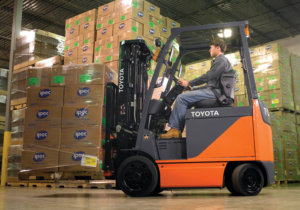Distance Between Forks On Forklift

Are your forklift operators due for refresher training? Or, observing unsafe driving? ProLift offers classes at your site and ours. SCHEDULE Training
Exercise you know the best fork position on your forklift? Knowing the right answer may seem insignificant, simply it is a skill that requires educational activity of the operator besides equally enforcement of the rules. It reduces accidents, but more chiefly reduces the severity of injuries when accidents do happen.
Forks: Driving
Due to the operator's reaction time and weight of the forklift, manufacturers judge it takes 15-twenty feet for a fully loaded forklift to stop from total speed.
A properly trained operator will comport his forks or load 4-half-dozen inches off the footing. This position is high enough to reduce contact with dock plates, expansion joints in concrete, uneven areas, slight slopes, inclines and droppings on operating surfaces. At four-6 inches the forks or load is low enough that if you striking a pedestrian, the severity of the injury is limited. [Notation: If you are operating on rough surfaces, the elevation may need to increase slightly.]
As an example, if a pedestrian steps out half dozen feet in front of an operator with the forks or load carried too loftier, the pedestrian could exist knocked down and dragged underneath the load confronting rotating tires for up to 10 feet of travel. The chance of survival is very slim.
Forks: Tilting
Per OSHA regulations, always tilt forks dorsum when carrying a load. While unlike loads require unique angles, a slight tilt is all that is needed on most lift trucks to help retain loads when a fast stop is required. Unstable, round, liquid or loose stacked loads may require higher degrees of tilt back.
Forks: Parking
Forks on the ground are a trip hazard. However, if the forks are on the basis, y'all get an opportunity to lift your foot as yous trip to recover balance. If a fork tip or heel is left up, a pedestrian stepping over can hook her human foot underneath and fall. This is referred to as a "hook autumn". Hook falls are unsafe because the human foot tin can't move and full body weight pulls on the foot during the autumn. The usual result is broken basic in the foot, talocrural joint or leg.
To achieve a rubber "parked" fork position, an operator lowers the forks completely with the mast vertical. The mast is then tilted slightly forward until the fork tips touch the flooring, preventing a pedestrian's claw autumn.
Aid limit the damage that tin can occur at your warehouse. Commit to knowing, following and enforcing the best positions for your forklift'south forks.
Have additional questions about forklift prophylactic? ProLift offers classroom and hands-on evaluation on the topics of forklifts, aerial lifts and slip steers. Contact our safety specialist to schedule preparation!
SCHEDULE TRAINING
Distance Between Forks On Forklift,
Source: https://www.prolifttoyota.com/blog/fork-position-of-a-forklift/
Posted by: gravellecousine.blogspot.com


0 Response to "Distance Between Forks On Forklift"
Post a Comment